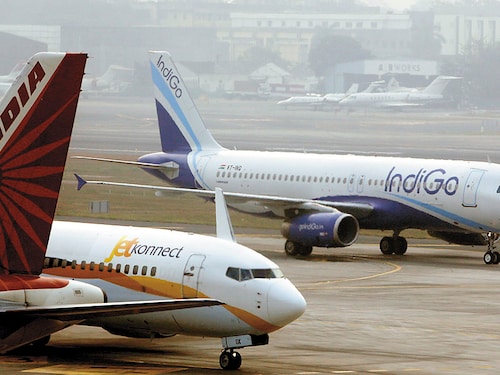Air India's fate uncertain; mild turbulence in the country's skies
Despite the recent slowdown, the Indian aviation sector is on the cusp of a boom period and Air India's survival, even as a private entity, is critical


Air India has an accumulated debt of `52,000 crore while IndiGo saw its profi t fall by 25% in the January-March quarter
Image: Vivek Prakash / Reuters
India’s domestic aviation market ended 2016 on a high note. The 100 million passengers that flew on domestic routes last year were the third highest in the world, topped only by the US (719 million) and China (436 million), according to data released by aviation think tank Centre for Aviation-CAPA.
This growth, however, seems to have fizzled out in 2017. After posting over 20 percent year-on-year growth in passenger traffic for 12 consecutive months, growth in air travel was below 15 percent from February to April this year.
While the deceleration is not big enough to impact the pipeline of over 800 aircraft orders that local airlines have placed with Airbus and Boeing, they may revisit expansion plans if volume growth wanes to single digits.
Compounding matters is a rise in aviation fuel prices. India’s biggest and most profitable airline IndiGo saw its profit fall by 25 percent year-on-year to Rs440 crore in the January-March period of 2017. The budget carrier attributed the fall to fuel prices that were 40 percent higher than in the year-ago quarter. Jet Airways too saw its profit drop by 90.7 percent to Rs36.8 crore in the last quarter of FY17.
For flag-carrier Air India (AI), the problems are more acute. The country’s third largest airline by market share, which has Rs52,000 crore in accumulated debt, is reportedly on the block after government think tank Niti Aayog recommended a complete privatisation. But Civil Aviation Minister Ashok Gajapathi Raju believes finding a “strategic investor” may not be easy.
According to Jitender Bhargava, former executive director of AI, privatisation is the only remedy. “I’m convinced that AI, in its current avatar, can neither survive nor be revived.”
That said, the airline’s survival, even as a private entity, is critical. “AI has a 14 percent domestic market share and a 20 percent international market share, which is not easy to replace, particularly in the international sector,” says Bhargava. He says the airline’s debt does not reveal the entire story. “AI has tangible assets such as real estate, slots and parking spaces at international airports, engineering services, ground handling services and subsidiary companies, besides running a pilot training academy.” The AI building at Nariman Point, Mumbai, is worth Rs1,800 crore, adds Bhargava.
“There are several factors to consider for the sale of AI—[employee] unions, debt etc,” says Manish Agrawal, leader-capital projects and infrastructure at PwC India. Despite the current turbulence in the sector, he remains optimistic. “The overall trend suggests that it [aviation] is a fast-growing market. In terms of India’s per capita income levels, India is at a cusp where air travel can suddenly shoot up.”
A recent research report by Morgan Stanley Investment Management supports this view. It forecasts domestic air passenger traffic to grow at a CAGR of 13 percent between FY16 and FY26 and expects a capex of $25 billion in the 10-year period, primarily for upgrading infrastructure.
First Published: Jun 19, 2017, 07:31
Subscribe Now